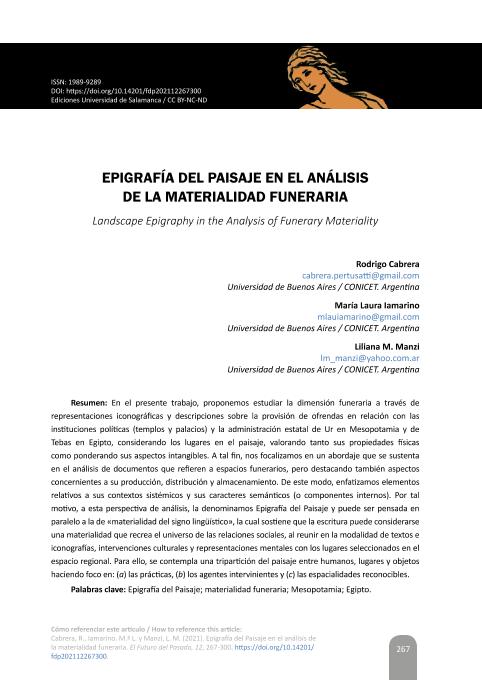Artículo
En el presente trabajo, proponemos estudiar la dimensión funeraria a través de representaciones iconográficas y descripciones sobre la provisión de ofrendas en relación con las instituciones políticas (templos y palacios) y la administración estatal de Ur en Mesopotamia y de Tebas en Egipto, considerando los lugares en el paisaje, valorando tanto sus propiedades físicas como ponderando sus aspectos intangibles. A tal fin, nos focalizamos en un abordaje que se sustenta en el análisis de documentos que refieren a espacios funerarios, pero destacando también aspectos concernientes a su producción, distribución y almacenamiento. De este modo, enfatizamos elementos relativos a sus contextos sistémicos y sus caracteres semánticos (o componentes internos). Por tal motivo, a esta perspectiva de análisis, la denominamos Epigrafía del Paisaje y puede ser pensada en paralelo a la de «materialidad del signo lingüístico», la cual sostiene que la escritura puede considerarse una materialidad que recrea el universo de las relaciones sociales, al reunir en la modalidad de textos e iconografías, intervenciones culturales y representaciones mentales con los lugares seleccionados en el espacio regional. Para ello, se contempla una tripartición del paisaje entre humanos, lugares y objetos haciendo foco en: (a) las prácticas, (b) los agentes intervinientes y (c) las espacialidades reconocibles. In this paper, we propose to study the funerary dimension through iconographic representations and descriptions about the provision of offerings in relation to political institutions (temples and palaces) and the state administration of Ur in Mesopotamia and Thebes in Egypt, considering the places in the landscape, valuing both its physical properties and weighing its intangible aspects. To this end, we focus on an approach that is based on the analysis of documents that refer to funeral spaces, but also highlighting aspects concerning their production, distribution, and storage. In this way, elements related to their systemic contexts and their semantic characters (or internal components) are emphasized. For this reason, we call this analysis perspective Landscape Epigraphy and it can be thought of in parallel to that of «materiality of the linguistic sign», which maintains that writing can be considered a materiality that recreates the universe of social relations, by bring together in the modality of texts and iconographies, cultural interventions, and mental representations with the selected places in the regional space. To do this, a tripartition of the landscape between humans, places, and objects is contemplated, focusing on: (a) practices, (b) agents, and (c) spatialities.
Epigrafía del paisaje en el análisis de la materialidad funeraria
Título:
Landscape Epigraphy in the Analysis of Funerary Materiality
Fecha de publicación:
07/2021
Editorial:
Universidad de Salamanca
Revista:
Futuro del Pasado
e-ISSN:
1989-9289
Idioma:
Español
Tipo de recurso:
Artículo publicado
Clasificación temática:
Resumen
Palabras clave:
ANDSCAPE EPIGRAPHY
,
EGYPT.
,
FUNERARY MATERIALITY
,
MESOPOTAMIA
Archivos asociados
Licencia
Identificadores
Colecciones
Articulos(IMHICIHU)
Articulos de INST.MULTIDISCIP.DE HISTORIA Y CS.HUMANAS
Articulos de INST.MULTIDISCIP.DE HISTORIA Y CS.HUMANAS
Citación
Cabrera, Fernando Rodrigo; Iamarino, Maria Laura; Manzi, Liliana Mabel; Epigrafía del paisaje en el análisis de la materialidad funeraria; Universidad de Salamanca; Futuro del Pasado; 12; 7-2021; 267-300
Compartir
Altmétricas




